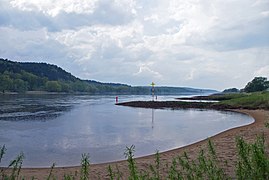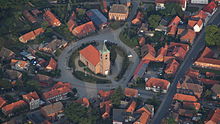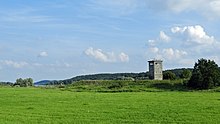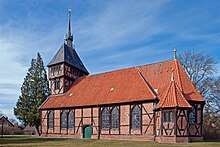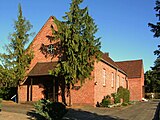Neuhaus Office
| coat of arms | Germany map | |
|---|---|---|

|
Coordinates: 53 ° 17 ' N , 10 ° 56' E |
|
| Basic data | ||
| State : | Lower Saxony | |
| County : | Luneburg | |
| Height : | 6 m above sea level NHN | |
| Area : | 237.24 km 2 | |
| Residents: | 4965 (Dec. 31, 2019) | |
| Population density : | 21 inhabitants per km 2 | |
| Postal code : | 19273 | |
| Primaries : | 038841, 038845 | |
| License plate : | LG | |
| Community key : | 03 3 55 049 | |
| Community structure: | 7 districts | |
| Address of the municipal administration: |
Am Markt 5 19273 Neuhaus office |
|
| Website : | ||
| Mayor : | Andreas Gehrke ( CDU ) | |
| Location of the municipality of Amt Neuhaus in the district of Lüneburg | ||
Amt Neuhaus is a municipality in the Lower Saxony district of Lüneburg , which was formed on October 1, 1993. The communities that were absorbed into this unified community Amt Neuhaus belonged to the Mecklenburg-Western Pomerania district of Hagenow until June 29, 1993 . The name is reminiscent of the old Neuhaus office as an administrative district in the Kingdom of Hanover .
geography
Geographical location
The area of the municipality lies in the glacial valley of the Elbe north of the Elbhöhen-Wendland nature park and is itself completely part of the Lower Saxon Elbe Valley Biosphere Reserve . In the northern area the municipality is crossed by the Sude . The Rögnitz flows into the Sude near Sückau after it has also flowed through the municipality from the southeast. The main watercourse in the municipality is the Elbe, which forms the southwestern municipality boundary, and the Krainke , which runs parallel to it . This rises west of Woosmer in Mecklenburg and flows northwest to the confluence with the Sude through most places in the municipality, such as Tripkau , Kaarßen , Zeetze, Stapel and Neuhaus along the Carrenziener Heide , an approximately 4500 hectare forest area. Bundesstraße 195 follows the course of the Krainke . Between the road and the Elbe, the community is characterized by meadows that are drained through numerous canals and ditches. These meadow areas are usually at a height of approx. 10 m above sea level. NN. The highest point in the municipality is 35.7 m above sea level. NN in the wooded drifting sand dune area of the Carrenziener Heide north of Stixe.
Community structure
The community consists of the seven localities
- Dellien , with Preten and Sückau
- Haar , with Darchau, Klein Banratz and Konau
- Kaarßen , with Bitter , Brandstade, Herrenhof , Laave , Privelack , Rassau and Stixe
- Neuhaus , with Rosien
- Stack , with Gutitz, Pommau, Vockfey and Zeetze
- Sumte with Gülstorf, Krusendorf , Neu Garge , Niendorf , Stiepelse and Viehle
- Tripkau , with Bohnenburg , Gosewerder, Laake , Pinnau , Raffatz, Strachau, Wehningen and Wilkenstorf
history
Old Office Neuhaus: 1689–1945

Since the beginning of the colonization in the east , the Neuhaus office with the Dartsingen / Darzing castle belonged to the Duchy of Saxony-Lauenburg ; After the death of the last Ascanian Duke Julius Franz in 1689, a brief dispute broke out over the Lauenburg part of the former duchy between the Electorate of Braunschweig-Lüneburg (Kurhannover) - later the Kingdom of Hanover - and the then Danish Holstein , as Georg Wilhelm von Braunschweig-Lüneburg Ratzeburg fortified what Holstein felt as a threat to his area. Only in the Hamburg comparison of 1693 did the area of the former duchy finally become part of the later Kingdom of Hanover. The old Ascanian Neuhaus Castle was demolished as early as 1698; the stones were used to build the Göhrde hunting lodge .
In 1810, Kurhannover was incorporated into the Napoleonic Kingdom of Westphalia and lost the Duchy of Lauenburg to the likewise Napoleonic department of the mouths of the Elbe . When the Kingdom of Hanover was constituted in 1814/15 as a result of the Congress of Vienna , the Duchy of Lauenburg ceded it to Denmark; only the Neuhaus office remained with Hanover. In 1820 Sumte and Krusendorf were incorporated into the area of the Neuhaus office, and in 1852 the Neuhaus district court in Lauenburgschen was established. The Kingdom of Hanover, in turn, was annexed by Prussia as the Province of Hanover in 1866 as a result of the Austro- Prussian War lost on Austria's side , which dissolved the Neuhaus office on April 1, 1885 and incorporated the area into the Bleckede district , which in turn was dissolved in 1932 was incorporated into the district of Lüneburg .
Until the end of the Second World War , almost the entire former area of the Neuhaus office still belonged to the Lüneburg district and thus to Hanover; only the village of Niendorf (incorporated into today's Sumte district in 1974 ) was then part of the state of Mecklenburg . After the Second World War, the former Hanoverian area initially belonged to the British zone of occupation for a short time , but for practical reasons (no bridge over the Elbe and correspondingly expected supply difficulties), it was transferred to the Soviet zone of occupation in July 1945 and, as a result, it belonged to the GDR .
Today's office in Neuhaus since 1992
After turning in May 1990 old independent municipalities were in the eight Dellien , hair , Kaarßen, Neuhaus / Elbe , stack , Sückau , Sumte and Tripkau municipal elections conducted on March 31, 1992, was the Official Neuhaus from the eight municipalities reformed. The eight municipal councils each unanimously decided to move to Lower Saxony. Until June 29, 1993 they still belonged to the Hagenow district of Mecklenburg-Western Pomerania . On June 30, 1993 they became part of the Lüneburg district again through a state treaty between the two federal states. The historic Mecklenburg town of Niendorf, which was incorporated into Sumte on January 1, 1974, also moved to Lower Saxony. Together with the eight municipalities of the Neuhaus office, the three districts of Neu Bleckede, Neu Wendischthun and Stiepelse were also reclassified from the municipality of Teldau to Lower Saxony. On June 30, 1993, Neu Bleckede and Neu Wendischthun were incorporated into the city of Bleckede and Stiepelse incorporated into the municipality of Sumte. In addition, the communities Dellien and Sückau were incorporated into the community Neuhaus / Elbe.
From June 30, 1993, the previous Neuhaus office with the six communities of Haar, Kaarßen, Neuhaus / Elbe, Stapel, Sumte and Tripkau continued to exist as an integrated municipality in Lower Saxony . On October 1, 1993, the six municipalities of the previous joint municipality of Amt Neuhaus were combined into a new unified municipality . Official districts and localities are today Dellien, Haar, Kaarßen, Neuhaus, Stapel, Sumte and Tripkau. Stiepelse and Sückau do not have this status. Although the municipality is no longer an office , the name Amt Neuhaus remained as the name for the unified municipality.
With the planned construction of a new Elbe bridge between Darchau and Neu Darchau in the Lüchow-Dannenberg district , the community should be better connected to the district town of Lüneburg . However, the construction of the bridge is controversial. Conservationists see the Lower Saxony Elbe Valley Biosphere Reserve in danger.
On June 7th, 2009, a public survey took place, in which the citizens were able to express their opinion about the merger of the municipality with the city of Bleckede and the municipalities of the Dahlenburg municipality . While the citizens of the Neuhaus and Dahlenburg offices approved the merger, almost two-thirds of them were rejected by those in the much larger city of Bleckede. The city administration presented this as ignorance of the citizens and therefore a second survey was carried out later. In this case, however, the rejection on the part of the Bleckeder was only clearer. One of the main reasons for the rejection is the financial situation - while Bleckede has comparatively few debts, Dahlenburg and above all Neuhaus are heavily in debt.
In the region, Low German is still often spoken today .
politics
Amt Neuhaus belongs to the Elbe state electoral district and the Lüchow-Dannenberg-Lüneburg electoral district .
advice
The council of the municipality of Amt Neuhaus consists of 14 council members. The municipal elections on September 11, 2016 led to the following result with a turnout of 61.6%:
| Party / list | Share of votes | Seats |
| CDU | 30.4% | 4th |
| left | 15.9% | 2 |
| SPD | 14.2% | 2 |
| FDP | 6.5% | 1 |
| The independents | 33.0% | 5 |
For the work in the 2016–2021 electoral period, the council members have organized themselves into two groups: three party group (8 seats) and the group The Independent / FDP (6 seats).
mayor
- 2011 – October 2019: Grit Richter (independent)
- from November 2019: Andreas Gehrke (CDU)
coat of arms
| Blazon : “The coat of arms is squared, it shows the top front (top left) and bottom back (bottom right) the diamond-shaped wreath coat of arms, a divided coat of arms in black and gold and covered with a green diamond-shaped wreath . In front below on a red field the picture of the Neuhauser Burg and in the back above on a red background in silver the Lower Saxony horse " | |
partnership
Since 2006 there has been a partnership with the small Polish town of Ryn in the Warmian-Masurian Voivodeship .
Culture and sights
Museums
- The local history museum in the old gate house shows the past and present of the community. The former teacher and local writer Werner Hüls (* 1926) and the Citizens Meeting Association oversee permanent and special exhibitions (including on the subject of forced resettlement in the restricted area of the GDR).
- The Storkenkate as an information center of the foundation "The Stork Foundation - storks for our children".
Buildings
- The village of Konau and the neighboring village of Popelau form a unified Marschhufendorf with its two-tiered Lower Saxon two-tier hall houses lying parallel to each other, the gables of which point towards the dike and with the farm section, stables, barns and shed houses that point towards the paddock and the Feldmark. It is the only completely preserved village of its kind in the world. The small St. Lukas Chapel located higher up also has an interesting GDR architectural history . It is the only church building that was erected in the restricted area at the time. The listed village is located directly on the dike in the middle of the Lower Saxony Elbe Valley Biosphere Reserve .
- From the remnants of the wall found in 2004 during dike construction work on the Elbe, a part of the village of Vockfey that had been demolished during GDR times , a thought pyramid and a documentation center were set up to remind people of forced resettlement and leveling.
- The St. Marien Church in Tripkau is known for its unusual interior. There was a church in Tripkau as early as 1618. This building was replaced in 1757 by a half-timbered church without a tower. The current church was built in 1864 when the building was expanded to include a choir, a sacristy and a tower. After a thorough renovation, the church was consecrated again in 1998.
- The old castle wall with remains of the old castle wall in Neuhaus is a remnant of the old duke's castle , which was removed in 1719. The Göhrde hunting lodge and the Blücher manor were built from the building material .
- The Marienkapelle in Stiepelse is a building from the middle of the 19th century that was renovated until 1997.
Natural monuments
- The Stixer Wanderdüne covers an area of around 9.5 hectares. Buried pine trees testify to the activity of the dune that still exists today.
traffic
Public transport
The Neuhaus office, like the entire Lüneburg district, is part of the Hamburg Transport Association . However, since there are no continuous public transport lines from the rest of the network area to the Neuhaus office and the bus traffic within the office is mainly used for school traffic, only HVV season tickets (especially those for schoolchildren) are recognized in the Neuhaus office, but no single or day tickets. These are therefore not sold on the buses.
railroad
The village of Neuhaus had a now disused and dismantled railway branch connection to the Berlin-Hamburg railway .
Street
By far the most important mode of transport in the Neuhaus district is private car traffic. The Neuhaus district is crossed by the federal highway 195 in a south-east-north-west direction. There are connections to the rest of Lower Saxony via two Elbe ferries. The Amt Neuhaus ferry connects Bleckede and the Neu Bleckede district on the right bank of the Elbe in the Lüneburg district . The Elbe ferry Tanja runs between Darchau and Neu Darchau in the Lüchow-Dannenberg district . A planned bridge construction at Neu Darchau was initially delayed for years due to legal disputes. In July 2015, the district council of the Lüneburg district decided not to build the Elbe bridge for cost reasons. Attempts had previously failed to get a higher grant from the state of Lower Saxony than originally promised and / or to get the state of Mecklenburg-Western Pomerania to co-finance.
religion
In the village of Neuhaus there is one Protestant and one Catholic church.
The Protestant church, executed in half-timbered construction, is located on the church square. Your parish belongs to the Bleckede parish in the Lüneburg district . There are other Protestant churches in districts belonging to the municipality of Amt Neuhaus.
The Catholic Church of the Assumption on Kirchstrasse was designed by Josef Fehlig and inaugurated in 1951 by Hildesheim Bishop Joseph Godehard Machens . It belonged to the West German diocese of Hildesheim during the GDR , but was subordinate to the Apostolic Administrator of Schwerin. Today the church belongs to the parish of St. Mary Queen of St. Rosary in Bleckede.
- Other churches and chapels in the Neuhaus district
Sons and daughters of the church
- Franz Julius Lütkens (1650–1712), Protestant theologian
- Anna Maria Franziska von Sachsen-Lauenburg (1672–1741), Princess of Sachsen-Lauenburg
- Wilhelm Dietrich Hermann Flebbe (1755–1837), Privy Councilor
- Carl Gravenhorst (1837–1913), lawyer and member of the Reichstag
- Carl Peters (1856–1918), publicist, colonialist and Africa researcher, founder of German East Africa
- Heinz Leidersdorf (1906–1943), resistance fighter against National Socialism
- Werner Conze (1910–1986), historian
- Paul Dräger (* 1942), classical philologist, translator and science historian
- Reinhard Borchert (* 1948), sprinter
- Rainer Balhorn (1955–1970), fatality on the inner-German border
- Till Backhaus (* 1959), SPD politician
- Jürgen Schult (* 1960), athlete and Olympic champion
Others
- At its meeting in October 2008, the council of the Neuhaus municipality revoked the honorary citizenship of Otto Telschow (1876–1945; NSDAP member, Gauleiter, State Councilor and Reich Defense Commissioner), although the municipality only came into being in 1993 and has not yet appointed any honorary citizens. Telschow was an honorary citizen in the former Neuhaus office, which existed until 1945.
- A project group has been dealing with a possible merger of the city of Bleckede , the municipality of Amt Neuhaus and the five municipalities of the combined municipality of Dahlenburg to form the new city of Elbe (project name) since 2008 . This city would have about 21,000 inhabitants on an area of 532 km².
- The Neuhaus office is legally an accession area, although it is in Lower Saxony. This means that for people who live or work there, e.g. B. the currently lower rated earnings points (East) are taken into account in the pension insurance and the lower additional earnings limits (East) also apply. The background to this is that the state treaty concluded between Lower Saxony and Mecklenburg-Western Pomerania cannot change the territorial regulations of the Unification Treaty , since it has higher priority than federal law .
Web links
Individual evidence
- ↑ State Office for Statistics Lower Saxony, LSN-Online regional database, Table 12411: Update of the population, as of December 31, 2019 ( help ).
- ↑ Districts of the municipality of Amt Neuhaus ( Memento from October 14, 2007 in the Internet Archive )
- ↑ Local election of the municipality of Neuhaus 2016 final result
- ↑ Announcement of the main statutes of the municipality of Amt Neuhaus after the council meeting on January 12, 2012 ( memento of October 29, 2015 in the web archive archive.today )
- ↑
- ↑ NimmBus: HVV expansion to the south (special case Neuhaus office)
- ^ Elbe ferries ( Memento from October 16, 2013 in the web archive archive.today ) In: Verkehrsinfo Region Hamburg. Ship & port. Authority for Urban Development and Environment Hamburg - Office for Transport and Roads. Retrieved August 1, 2009.
- ↑ Lüneburg district wants the bridge to continue. In: Hamburger Abendblatt, March 24, 2006.
- ^ District council: No plan approval procedure for Elbe bridge. ( Memento from July 3, 2018 in the Internet Archive ) Press release of the Lüneburg district, July 21, 2015.
- ↑ Nazi should no longer be an honorary citizen of the office. Schweriner Volkszeitung, September 25, 2008, archived from the original on September 25, 2008 ; accessed on October 28, 2015 .
- ↑ http://www.deutsche-rentenversicherung-regional.de/Raa/Raa.do?f=SGB4_18R4.1.2




